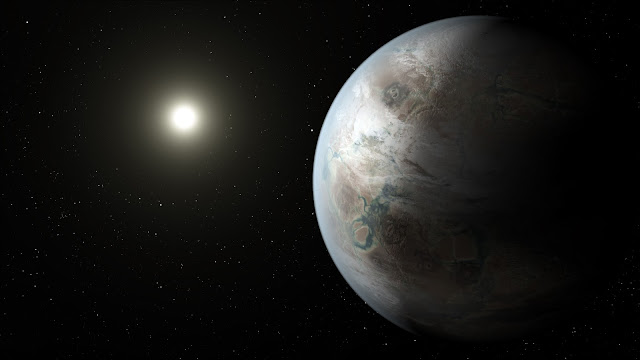 |
| An artist's concept of what Kepler-452b might look like from orbit (NASA Ames/JPL-Caltech/T. Pyle) |
We've now confirmed the existence of nearly 2,000 exoplanets in our neighborhood of the galaxy. There are still another three thousand or so possible finds that are awaiting confirmation, but there's a good chance many of them will turn out to be real planets as well. We still estimate maybe 160 billion (or more) planets exist in our galaxy alone (averaging 1.6 planets per star). These numbers are incredible, especially for those of us who remember a time when we had not yet confirmed the existence of planets around other stars.
Most of the worlds we have confirmed were first detected by the Kepler space telescope. Kepler was launched and entered service in 2009, immediately getting to the work of hunting for alien worlds. The mission had a highly successful lifetime of 3.5 years and was even granted a mission extension, but then, in 2013, a second of four of the reaction wheels within the spacecraft had broken (the reaction wheels are what allow such spacecraft to orient themselves in space without the need for fuel). Since that time, an ingenious repurposing of the spacecraft for a new planet-hunting mission called "Second Light" (a.k.a. K2) has been undertaken. Second Light has been operating since early 2014 and has been slowly building upon the list of potential exoplanets out there.
From all of the worlds discovered through Kepler's original mission and the Second Light mission, none has been as exciting for the general public as one that was just announced this past week. On July 23rd, researchers announced 521 more planet candidates, including 11 worlds that are close in their size and orbital distances from their stars as is our own Earth. One of those eleven is a world currently known as Kepler-452b. This exoplanet orbits a G2 star (one that is in the same spectral class as our Sun), it has an orbit that is similar in size to the Earth's (Kepler-452b's year is only 20 days longer), and this alien world is only about 1.6 times larger than the Earth. The following infographic from Space.com gives some fantastic details on what we've recently discovered about this exoworld:
The discovery of another world very similar to our own Earth is very suggestive that we are on the right path to discovering extraterrestrial life. Since my birth, we've now determined that there are billions of planets in our galaxy and we now know that some of them, like Kepler-452b, are very similar to our homeworld in their size and orbit (and some even orbit similar stars!). With current improvements in telescope technology and the development of exoplanet atmosphere research, it seems more and more like it really is only a matter of time before we start seeing abundant evidence for worlds that are habitable. Following that, how long might it be before the first detections of biosignature gases on exoplanets? If life is abundant in our universe, then it seems like we are only around the corner from finally determining whether we are alone in the vast cosmos.
Kepler-452b excites many people because of how similar it is to our world. Might there be a geophysical processes occurring on that world that are similar to ours? Might there be plate tectonics, continents, oceans...
We have a tendency to think that we need to find worlds like our own to find life (though this may not truly be the case), and that's why Kepler-452b is so exciting. I'm glad to know that so many people in the general public have been excited by this new finding. It might be that Kepler-452b is another Venus (a hothouse world devastated by a runaway greenhouse), or maybe the surface of Kepler-452b is simply a barren wasteland. Yet it's fun to imagine some of the more intriguing possibilities.
Maybe Kepler-452b has a surface covered in microbial mats that generate large amounts of gases that are far from equilibrium with the atmosphere. Maybe that world has gigantic creatures like walking trees, dinosaurs, or giant floating blobs. Maybe there are intelligent beings on that world that have also discovered math and science and who have orbiting space telescopes that are peering out into their galactic neighborhood. Maybe, if that's the case, then just maybe they're also holding exciting press conferences to share their findings of new exoplanets around other stars. Maybe they've even had a meeting to discuss this new planet that is just like theirs in it's orbit around a similar star. Maybe that planet is just a bit smaller. Does it also have life?
 |
| An artist's illustration of a possible surface of newfound planet Kepler-452b (SETI Institute/Danielle Futselaar) |

No comments:
Post a Comment